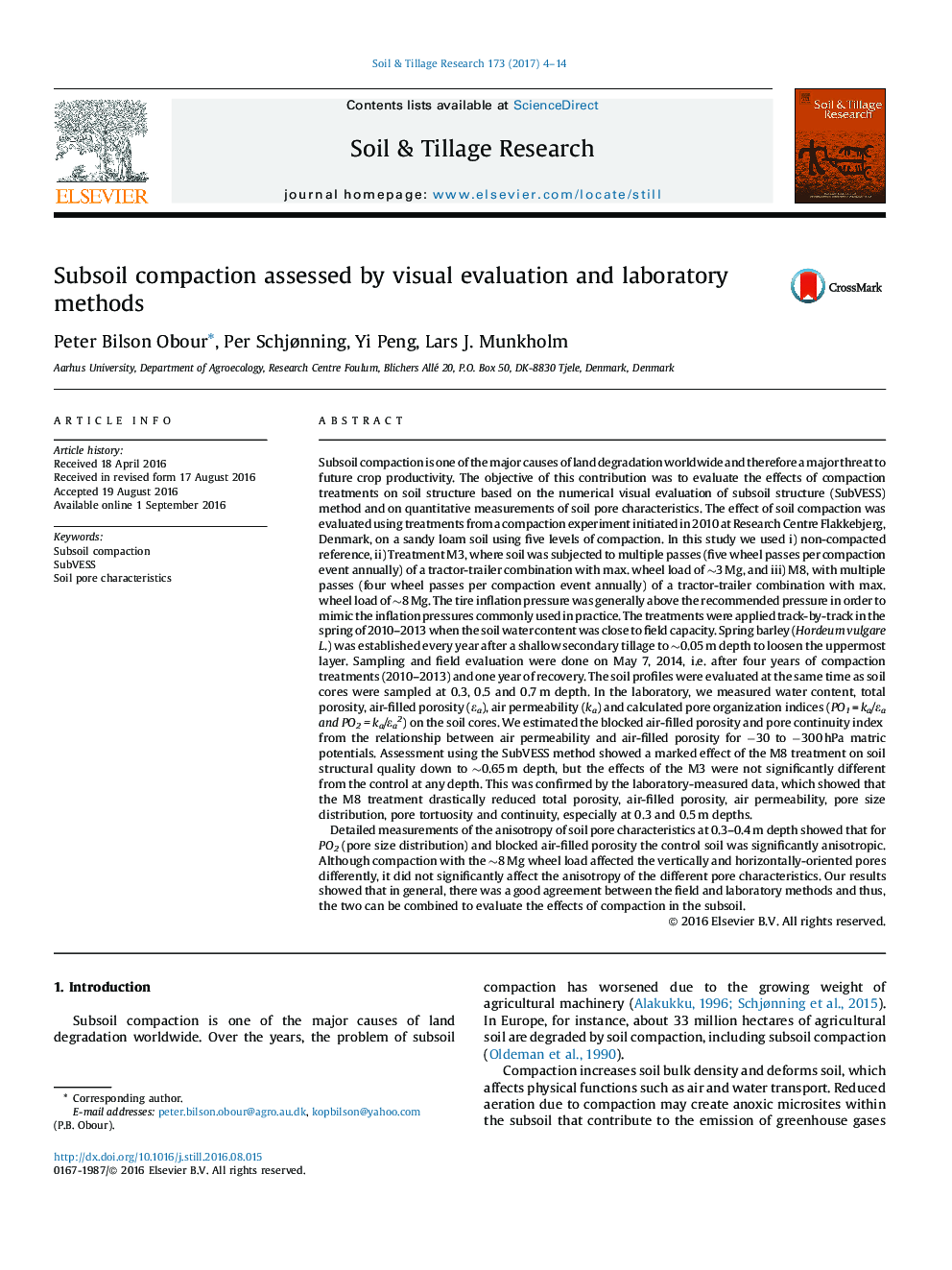| کد مقاله | کد نشریه | سال انتشار | مقاله انگلیسی | نسخه تمام متن |
|---|---|---|---|---|
| 4927480 | 1431830 | 2017 | 11 صفحه PDF | دانلود رایگان |
- The SubVESS is a simple and cost-effective method for detecting degraded soils.
- Compaction with the â¼8Â Mg wheel load deteriorated subsoil structural quality down to â¼0.65Â m depth.
- Compaction affected subsoil pore characteristics.
- Good agreement between Ssq scores from SubVESS method and laboratory-measured data.
- Compaction did not significantly affect the anisotropy of upper subsoil (â¼0.3-0.4Â m depth) pore characteristics.
Subsoil compaction is one of the major causes of land degradation worldwide and therefore a major threat to future crop productivity. The objective of this contribution was to evaluate the effects of compaction treatments on soil structure based on the numerical visual evaluation of subsoil structure (SubVESS) method and on quantitative measurements of soil pore characteristics. The effect of soil compaction was evaluated using treatments from a compaction experiment initiated in 2010 at Research Centre Flakkebjerg, Denmark, on a sandy loam soil using five levels of compaction. In this study we used i) non-compacted reference, ii) Treatment M3, where soil was subjected to multiple passes (five wheel passes per compaction event annually) of a tractor-trailer combination with max. wheel load of â¼3 Mg, and iii) M8, with multiple passes (four wheel passes per compaction event annually) of a tractor-trailer combination with max. wheel load of â¼8 Mg. The tire inflation pressure was generally above the recommended pressure in order to mimic the inflation pressures commonly used in practice. The treatments were applied track-by-track in the spring of 2010-2013 when the soil water content was close to field capacity. Spring barley (Hordeum vulgare L.) was established every year after a shallow secondary tillage to â¼0.05 m depth to loosen the uppermost layer. Sampling and field evaluation were done on May 7, 2014, i.e. after four years of compaction treatments (2010-2013) and one year of recovery. The soil profiles were evaluated at the same time as soil cores were sampled at 0.3, 0.5 and 0.7 m depth. In the laboratory, we measured water content, total porosity, air-filled porosity (εa), air permeability (ka) and calculated pore organization indices (PO1 = ka/εa and PO2 = ka/εa2) on the soil cores. We estimated the blocked air-filled porosity and pore continuity index from the relationship between air permeability and air-filled porosity for â30 to â300 hPa matric potentials. Assessment using the SubVESS method showed a marked effect of the M8 treatment on soil structural quality down to â¼0.65 m depth, but the effects of the M3 were not significantly different from the control at any depth. This was confirmed by the laboratory-measured data, which showed that the M8 treatment drastically reduced total porosity, air-filled porosity, air permeability, pore size distribution, pore tortuosity and continuity, especially at 0.3 and 0.5 m depths.Detailed measurements of the anisotropy of soil pore characteristics at 0.3-0.4 m depth showed that for PO2 (pore size distribution) and blocked air-filled porosity the control soil was significantly anisotropic. Although compaction with the â¼8 Mg wheel load affected the vertically and horizontally-oriented pores differently, it did not significantly affect the anisotropy of the different pore characteristics. Our results showed that in general, there was a good agreement between the field and laboratory methods and thus, the two can be combined to evaluate the effects of compaction in the subsoil.
Journal: Soil and Tillage Research - Volume 173, November 2017, Pages 4-14
